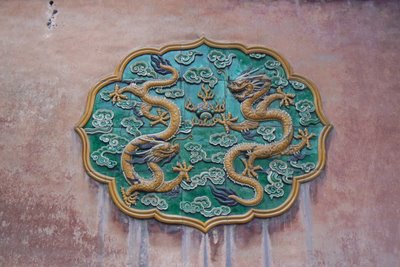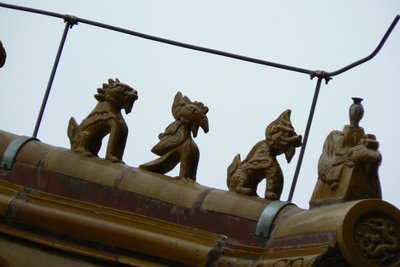Anyway the first stop was to Tianmen Square, and the Forbidden City right across the way. Tianmen Square is really boring. It's a big stone courtyard, flanked by really ugly Soviet style architecture, ugly in a way that puts the ugliness of any Shanghai Government architecture to shame. It still remains massive and crowded.

I guess you could say it's popular the same way Washington DC is, despite similarly having nothing to offer outside of government kitsch. Most noticeable was a spectaculalry long line, it led to a mausoleum where you could catch a few second's glimpse of Mao Zedong's pickled corpse. I didn't partake, but I did take a picture of a very Communist-looking statue, right outside.

And maybe you can see from squinting at the top picture, the portrait of Mao looking over the Square isn't nearly as large and imposing as it always looks in the magazine articles about China. Perhaps it's poetic license?
Anyway the gate under the portrait leads to the Forbidden City, where after walking for half a mile or so, you finally enter the main compound. The Forbidden City is immediately stunning, if for no other reason than that it's spectacularly large. This is just a portion:
There was a lot to see. A favorite was the massive gilded lions flanking the various gates:

Scattered about were some glazed wall tiles and displays, some of them were extremely beautiful.

This turtle opens itself to Freudian analysis?

If there's a complaint to be made, it's that it can at times have the feeling of a barn. Corners of the palace could be surprisingly empty and peaceful, but also had grass overgrowing the roof. And from what I understand, most of the insides were carted away by Chiang Kai-Shek, and are now on display in a Taiwanese museum. So many of the buildings were closed, and when the insides were open, the exhibits were sparse and didn't match the opulence of the outsides. I don't want to concentrate on the negatives, however, there was still a lot to see, and just the scale made it all the more impressive. Rather than ending on a negative note to a very impressive site, I'll show the cool little figurines, put on the cornerstones of the rooftops:

That night I decided to have a look at what music I could find! While I often talk bad about Shanghai's music scene, Beijing's seemed better. Of course it's hard to tell from one single night of going out to check the scene, but that one single night I did go out was to a really cool spot, with a casual feel, a friendly crowd, and cheap bottles of my favorite Chinese draft beer. Maybe the music wasn't quite my normal style, but overall it was still much superior anything I've run across in Shanghai.
Oh, and then I started talking to some musicians I met in the audience, and we were talking about old-school 30s blues musicians, and maybe we were drinking too much, and I dared them to go onstage and play, and they dared me to go up there and sing with them, and we did it. I was terrible, I freely admit it, but they were awesome and it was a lot of fun. I snapped a picture onstage:

Anyway I'll have more to say on Beijing soon, stay tuned!
(And if the videos don't work, that's probably because of the Taiwanese earthquake disrupting Internet service - check back later, although it may take a while)
"And from what I understand, most of the insides were carted away by Chiang Kai-Shek, and are now on display in a Taiwanese museum"
ReplyDeleteThe National Palace Museum in Taiwan has probably the single largest and best collection of Chinese artifacts anywhere. It's worth visiting if you ever find yourself in Taipei.
That the KMT moved China's cultural treasures protected them from damage and loss both from the invading Japanese army and the Cultural Revolution. Though they couldn't have predicted the latter, I think the Generalissimo had the former in mind when he had everything carted (and likely barged, or carried by donkeys or on the backs of coolies) off.